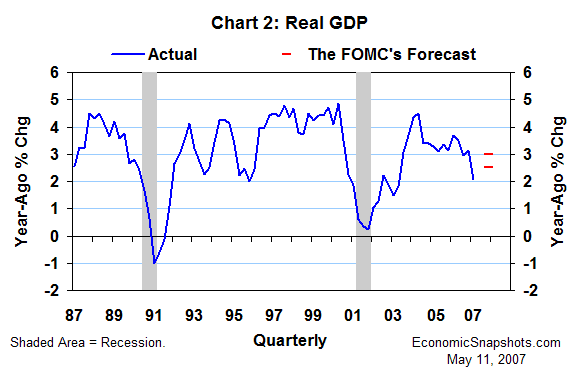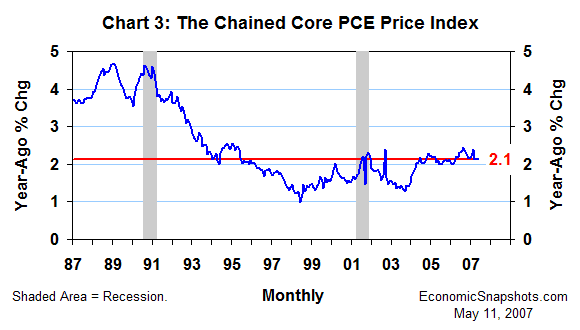
| Back to Index |
May 11, 2007 – The FOMC voted on Wednesday to leave its target Fed funds rate unchanged at 5.25% (Chart 1). The target Fed funds rate has been unchanged at 5.25% since June last year. Before then, the FOMC had been in tightening mode, raising its Fed funds target by a total of 425 basis points, over a two-year time span.

Based on the FOMC’s post-meeting policy statement, little has changed since its last policy meeting in March.
Real economic growth “slowed” in Q1, and the housing market remained weak. But, the FOMC still expects the economy to “expand at a moderate pace over coming quarters”.
In the data received since the FOMC last met, real GDP rose at a mere 1.3% annual rate in Q1 (compared to Q4), and by 2.1% compared to Q1 last year (Chart 2). As a rough guide to what “moderate” might mean, the FOMC’s February consensus forecast calls for real GDP growth of 2.5% to 3% in Q4, compared to the same quarter last year.

Core inflation remains “somewhat elevated” in the latest data, but FOMC members still expect inflation to slow to a more acceptable pace, “over time”. According to the minutes of the March FOMC meeting, the FOMC majority expects this slowing to be spread out “over the next year or two”.
The chained price index for personal consumption expenditures excluding food and energy (also known as the chained core PCE price index, the FOMC’s preferred inflation indicator) rose by 2.1% in the twelve months through March (Chart 3). This index has been trending in a 2% to 2.5% range for about three years. The FOMC majority seems to prefer a core inflation trend of 1.5% to 2%.

As in March, the FOMC said it continues to worry more about the upside risks to inflation than the downside risks to economic growth. In a stronger economy, this would sound like a tightening message. At present, however, it seems to be the FOMC’s way of letting us know that it has no immediate easing plans, despite the economy’s recent weakness. That view might change if economic growth fails to improve in Q2.
As far as the outlook for U.S. monetary policy is concerned, March’s message still applies. “Future policy adjustments will depend on the evolution of the outlook for both inflation and economic growth, as implied by incoming information.” In other words, “wait and see”.
Suzanne Rizzo